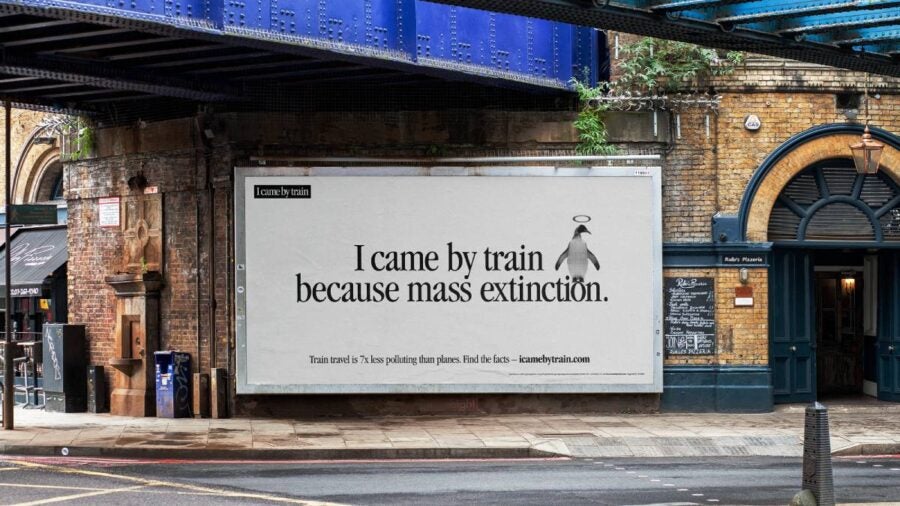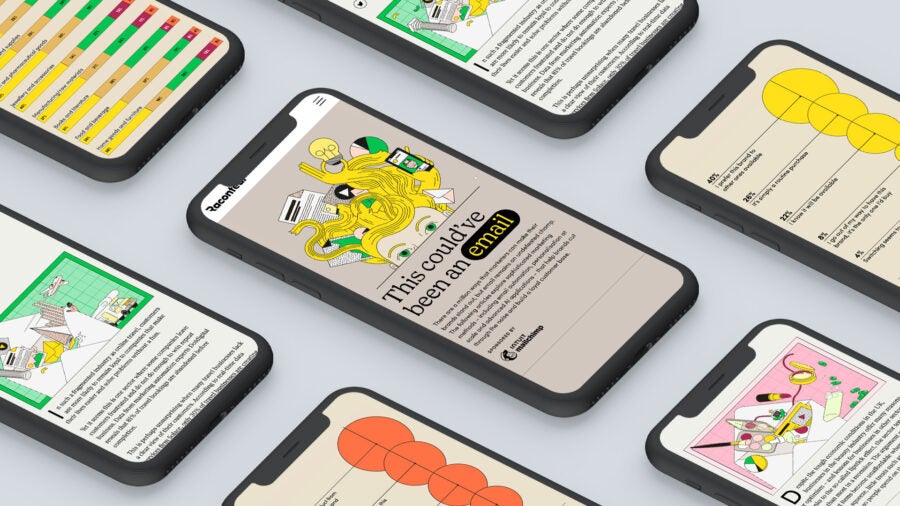
Branded content comes in many forms, from video adverts to thought leadership appearing in newspapers and magazines. When developed and marketed successfully, such content can raise brand awareness, influence purchasing decisions and help firms to achieve strategic business goals.
But what makes branded content “good”? And how can brands ensure the effectiveness of their content marketing strategy?
There is a growing consensus among marketers that good content aims to influence both hearts and minds. As a starting point, it should be informative, intelligent and guided by data-driven insights. But it must also be relatable, enticing and empathetic to the challenges that customers are facing. Balancing these attributes is no easy task – it is a matter of both art and science.
The benefits of getting the balance right are potentially significant. Nearly two-thirds of B2B buyers engage with at least three pieces of branded content before reaching out to a sales representative, according to research by ON24, a digital events platform. The ability therefore to create engaging content could be the difference between making a sale or not.
Marketing teams recognise this reality. A staggering 97% of brands invest in content marketing because it aligns with modern customer preferences, according to Semrush’s The State of Content Marketing 2023 Global Report. Other surveys have found that B2B business leaders believe content marketing produces higher-quality leads than traditional marketing strategies.
It is because marketers understand the value of strong branded content that the landscape for this form of marketing has become crowded, making it difficult to stand out. Consumers are arguably exposed to more advertising now than at any time in history, which is why creating content that engages consumers on multiple levels is so important.
Here, three content marketing experts discuss how their organisation achieves this by combining art and science in the creation and execution of branded content.
The 10 Group x Marks & Spencer
Eddie Hammerman, MD, The 10 Group
Science is the starting point of any creative campaign. We begin by gathering data on trending topics, which helps us to identify areas that are already crowded as well as those that present opportunities to reach consumers. What we’re looking for is ‘white space’ – gaps in the market where we can add something innovative and interesting, or a new position to occupy, either for us or our clients. Data is essential for determining success metrics at the beginning of a project. Insights informed by data help to shape creative initiatives and determine the channels through which we’ll deliver them.
But we’re always chasing a kind of intangible moment. Modern marketers have a sense for it – when you know that you’ve got something potentially shareable that people will want to talk about. Such moments emerge through a combination of hard data and creativity; through art and science. Statistics and technical insights presented by experts are great but they’re not enough in isolation to motivate mass behavioural changes.

We recently created a campaign for Marks & Spencer that merged these two components effectively. A long-term goal for M&S is to become the number-one supermarket for healthy food. They approached us because they wanted to raise awareness of their ‘Eat Well’ range and at the same time educate people on how to make healthier food choices.
To do this, we entered into a partnership with the Football Association (FA). But this high-profile partnership was not enough on its own to produce a successful marketing campaign. We had to first determine precisely what the message and intention of the campaign would be. Then, by using footballers that consumers like and idolise, we can reach people with that message, which they might not have been interested in or paid attention to had it been delivered in another way.
We’re always chasing a kind of intangible moment – when you know that you’ve got something potentially shareable that people will want to talk about
We decided that ‘Eat Well, Play Well’ would be the key message. It’s simple, it’s easily understood by consumers and it’s clearly relevant to M&S’s partnership with the FA and the supermarket’s goal of promoting healthy food. We conducted our own research on the nutrition habits of people living across the UK and used the findings to set the tone for the campaign across different channels.
Timing for the campaign was also important to its success. It was launched in July, so our efforts to spread the messaging in the early stages of the campaign aligned perfectly with the return to school in early September and the start of the Premier League season. The latter opened up opportunities to film content with players, enabling a multi-format and multi-channel strategy.
We conducted a live Q&A on Instagram with former England midfielder Jermaine Jenas and social media interviews with current players including Marcus Rashford and Kyle Walker. These discussions centred on their nutrition habits and favourite meals from M&S’s Eat Well range. We also positioned M&S’s nutritionist as a thought leader with interviews on Sky Sports News and several other channels, so that messaging was consistent across different platforms and reached a mass audience.
Finally, to generate PR and earned media, we compiled a research report titled Plate of the Nation, which backed up our content with data and dietary advice from players and sports nutritionists.
At the heart of all of this content were human stories that resonated with everyday people. Tyrone Mings, for instance, discussed his struggle to maintain a healthy diet when he worked in an office before becoming a professional player. Changing his eating habits, he said, led to significant improvements in his self-confidence and overall mental wellness.
Our interview with Marcus Rashford was particularly impactful. He shared some powerful stories about his childhood diet, the nutrition habits of his family and his efforts to influence them to eat better. It was a perfect reflection of this campaign because it’s exactly what M&S wanted to achieve: to inspire normal people to make healthier food choices.
These relatable human stories are essential if consumers are to connect with your content and messaging. People typically won’t be motivated to act on the basis of data alone. Campaigns land better when brands are able to combine hard data and expert opinion with stories that people can relate to delivered by people that they trust. For me, that is the result of the perfect blend of art and science in content creation.
Mother London x Trainline
Omar El-Gammal – Head of cultural insight and former strategy director, Mother
At Mother, we have a fluid and ambitious approach to art and creativity in content creation. Rather than adhering to a specific framework or set of principles, we aim to always do what’s best for the brief.
We talk a lot about ‘logical insanity’ – it would be insane to attempt to solve a creative problem with a purely logical, or ‘science-based’, solution. You can tick boxes with such solutions – for instance, the data tells you to do ‘X’ and you do it – and that can help to validate your activities for other stakeholders. But if your initiatives are determined solely by ‘the next logical action’, or if your processes preclude creativity and deviation, then you’re unlikely to win the competition for customers’ eyes and ears.
But although art and creativity are what differentiate brand campaigns, creatives should not discount the power of science and creativity. Don’t forget that science also has curiosity and imagination at its heart. What is science if not trying to get a deeper understanding of why things are the way they are? Data insights are therefore incredibly important to what we do in our creative work. But they have their limitations. Someone once told me that data is just opinions codified and I have never forgotten that wisdom.

In 2022, we created the ‘I Came By Train’ campaign for Trainline, which is a great example of how we merge art and science together when we create advertising campaigns. The goal of this campaign was to use environmentally focused messaging to convince people to travel by train, rather than use planes or automobiles. We needed people to associate train travel with sustainability, and to do this we needed hard data to back up our message that train travel is the more environmentally friendly option.
When we looked into the science, we were shocked to see that transport was the biggest category for carbon emissions in the UK. To put it into perspective, if you were to fly from London to Edinburgh (the nation’s most popular domestic flight), your carbon footprint, owing to that one flight, would be larger than that of the average person in about 10 different African countries in an entire year.
Presenting data this way may shock people and some environmentally focused campaigns use strategies such as these to attempt to shame people into changing their behaviour. But this approach ignores an important insight into human emotion: pride is a greater behavioural motivator than shame.
We talk about ‘logical insanity’ – it would be insane to attempt to solve a creative problem with a purely logical solution
We wanted our messaging to be relatable. We didn’t want to set unreasonably high standards for people and we didn’t want to suggest that they make wholesale lifestyle changes. We just wanted to make clear that each time people choose to travel by train rather than some other mode of long-distance transportation, they are having a meaningful impact on the environment. It’s a campaign built around positive messaging, tapping into those consumer behavioural insights. Why shouldn’t consumers feel good about the small decisions they make?
Our strategy was to stop ‘flight-shaming’ and start ‘train-bragging’. “I came by train”, as a message, was shorthand for, “I care about the environment and I’m willing to change just one journey a year to have a meaningful impact.”
Travelling by train can be a more expensive option, especially for those who are ineligible for a railcard. Younger people were therefore better able to make the shift to rail without too many price barriers, so that demographic was an important consideration during the ideation process of the campaign.
To connect with a mass audience, we needed to tie together the science and data we’d discovered with a creative idea and artistic execution. We decided to deliver our message using an original track and animated music video illustrating the coexistence of people, nature and transport. Craig David was the perfect choice for the face of the campaign, as he was having a moment as a national treasure. He had just performed at the Queen’s Jubilee and he was connecting across all age groups.
It was science that kept the campaign grounded, but artistry made it powerful. People are fundamentally emotional beings – they seek connection, excitement and joy. Attention to these emotional drivers is what ultimately made the campaign a success. So while writing a song with Craig David about taking the train more often is not an idea that can be generated by science, without the data to back up the messaging, the execution might seem a bit silly.
Raconteur x Mailchimp
Tom Watts – Creative director, branded content, Raconteur
From my perspective, combining art and science in content creation ends up being a circular process. Of course, it has to start with a broad understanding of what a client wants and who they want to reach. But even with a broad target in mind, in terms of campaign strategy and execution, you’re kind of shooting into the ether in the early stages.
A client wants to target a particular audience and they’ll often have an idea in mind about how they want to deliver their message to that audience. But a client may want one thing, but need something else if their campaign is to have the greatest impact.
Right away the art component shows up: how do we present this content in a way that readers will find engaging? A client wants to market their product to an audience. That product has benefits and maybe those benefits are even quantifiable. But no one wants to read a spec sheet. If you’re not presenting the information in an engaging way, you might be wasting your efforts.
So how do we create engaging content that readers can relate to? It can’t be done without both art and science. A great example of how Raconteur combines these is the work we did with Mailchimp.

For this particular project, Mailchimp was trying to tap into tech-savvy marketers, particularly at smaller businesses. This is a demographic of marketers that tend to have smaller budgets and maybe don’t have access to extensive internal resources or training budgets
With this in mind, it could have been tempting to structure this campaign around the cost of Mailchimp services or their ease of use – all things that are included in a normal sales pitch. But it takes a creative mindset to step back and focus on what the audience really cares about.
What does the audience care about? There’s a science to figuring that out. We have access to several different sources of data, both third-party and first-party. From our own data, we knew what kind of content the target audience was engaging with already and we can go back and do forensics on that content to determine what exactly the audience found interesting or engaging. We can figure out their intent and we can test different types of content with the audience before we go live with a campaign.
Then with third-party tools like Bombora and Semrush we can determine what topics or types of content were tracking well and what was helping them be successful in search and other types of digital discovery. With these two data streams we can make important decisions about formats, for instance, but this data is also important in the feedback loop later in the process.
Now we know what kind of content the audience finds most engaging, what they’re searching for and how they’re searching for it. But to make an impact and be memorable we need to position Mailchimp and their services as an attractive proposition – it’s about making them stand out. As any marketer knows, this is much easier said than done.
No one wants to read a spec sheet. If you’re not presenting the information in an engaging way, you might be wasting your efforts
Clients are often too eager to talk about their products; the price, the features, etc. But, frankly, that is not what’s going to convince people to read your content and it’s not what people care about when they make B2B purchases.
We’re out there talking to business leaders all the time; it’s what we do. These are the people who are making purchasing decisions and deciding how much budget should be allocated to different initiatives. We knew what audience Mailchimp was trying to reach and we knew from our own interactions with those people that when it comes to purchasing these types of services, one of the things they really care about is trust.
That might sound weird and it certainly isn’t something we would have assumed, but it turns out it’s a fundamental consideration. So the result was a campaign spread across various formats that touched on automation and personalisation, but also highlighted issues that aren’t immediately obvious, such as trust.
We can see from the results of this campaign that this marriage of art and science in this case was successful. The Mailchimp content has had high traffic, high duration times and, most importantly, the most engaged readers have been exactly the kind of people Mailchimp wanted to target. We weren’t aiming for the general C-suite, it was for manager-level marketers. If it had been for the C-suite we would have taken a different approach and framed the message differently. But it’s because we’re in the market talking to these people and understanding what they really care about that we’re able to create content that they find compelling.
Science helps you to start sketching the pathway and it works as reassurance that the steps you’re taking are the right ones, but art is what brings a campaign to life. It’s how you turn content about email marketing into engaging, human stories that readers will connect with.
Find out more about how Raconteur can help you and your brand successfully combine the art and science of content.

Branded content comes in many forms, from video adverts to thought leadership appearing in newspapers and magazines. When developed and marketed successfully, such content can raise brand awareness, influence purchasing decisions and help firms to achieve strategic business goals.
But what makes branded content “good”? And how can brands ensure the effectiveness of their content marketing strategy?
There is a growing consensus among marketers that good content aims to influence both hearts and minds. As a starting point, it should be informative, intelligent and guided by data-driven insights. But it must also be relatable, enticing and empathetic to the challenges that customers are facing. Balancing these attributes is no easy task – it is a matter of both art and science.
